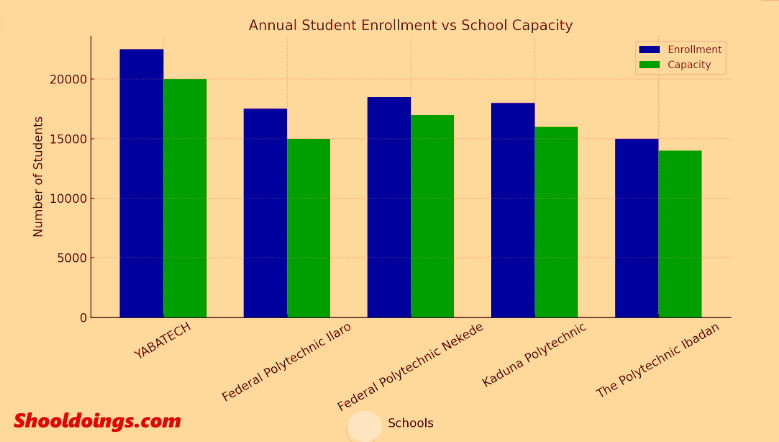Nigerian polytechnics are experiencing rapid growth in student populations, driven by the increasing demand for skilled workers in fields like engineering, technology, and business.
With a fast-rising population of over 220 million, Nigeria boasts one of Africa’s largest youth demographics.
The five most populated polytechnics in Nigeria collectively enroll approximately 86,000 to 97,000 students annually.
These figures illustrate the significant role these institutions play in Nigeria’s higher education system, catering to the educational needs of tens of thousands of students annually.
This surge has led many young Nigerians to pursue higher education and technical training, making polytechnics critical institutions for workforce development.
This article highlights the most populated polytechnics in Nigeria, exploring the factors behind their growth, the diverse programs they offer, and the challenges they face in managing their expanding student bodies.
Why Polytechnics Are Gaining Popularity
Polytechnics in Nigeria are becoming the go-to choice for many Nigerian students due to their focus on hands-on skills and practical learning.
With increasing demand for industry-ready graduates, several polytechnics have emerged as top institutions, attracting thousands of students annually.
Here are some reasons why enrollment at Nigerian Polytechnics is skyrocketing:
- Practical Learning:
Students are drawn to polytechnics because they offer hands-on training, giving them the practical skills needed in industries like engineering, technology, and business.
- Strong Industry Connections:
Many polytechnics have forged solid partnerships with industries, allowing students to secure internships and jobs after graduation.
- Affordability:
Polytechnics are a more economical route to higher education compared to universities, yet they still maintain high educational standards.

The Most Populated Polytechnics in Nigeria (2025 Update!)
Here’s a closer look at some of the polytechnics with the largest student populations:
1. Yaba College of Technology (YABATECH)

- Location: Lagos
- Student Population: Approximately 20,000 – 25,000 students
- Programs Offered: Over 60 National Diploma (ND), Higher National Diploma (HND), and postgraduate programs
Key Insights: YABATECH has built a reputation as a leading institution, thanks to its wide range of programs in engineering, business, and the arts. Its modern facilities and long-standing tradition continue to attract students from all over the country.
2. Federal Polytechnic, Ilaro

- Location: Ogun State
- Student Population: Around 15,000 – 20,000 students
- Programs Offered: More than 40 programs
Key Insights: With a strong emphasis on technical education, particularly in engineering and business, Federal Polytechnic Ilaro has expanded rapidly, thanks to its academic achievements and ongoing infrastructure improvements.
3. Federal Polytechnic, Nekede

- Location: Imo State
- Student Population: 18,000 – 19,000 students
- Programs Offered: Over 50 programs, including engineering, business, and environmental sciences
Key Insights: Known for its academic rigor and practical training, Federal Polytechnic Nekede is a top choice for students from Nigeria’s Southeast.
4. Kaduna Polytechnic

- Location: Kaduna State
- Student Population: 18,000 students
- Programs Offered: More than 70 programs
Key Insights: As one of Northern Nigeria’s largest polytechnics, Kaduna Polytechnic offers a wide variety of courses in engineering, social sciences, and environmental studies, drawing students from across the country.
5. The Polytechnic, Ibadan

- Location: Oyo State
- Student Population: Around 15,000 students
- Programs Offered: More than 60 programs
Key Insights: Renowned for its technical and managerial courses, The Polytechnic, Ibadan has maintained its status as a top institution in the Southwest.
Statistical Chart Showing Student Enrolment by Polytechnics Capacity Annually

Common Challenges Faced by Nigeria’s Most Populated Polytechnics
With the rapid rise in student numbers, these polytechnics are grappling with several challenges, including:
- 1. Overcrowded Classrooms:
Some lecture halls and laboratories are so packed that students joke about standing room only, making it difficult for instructors to deliver quality, hands-on training.
- 2. Limited Infrastructure:
The growing student populations are stretching available resources. For instance, you might find students struggling to secure hostel accommodation or laboratory access due to limited facilities.
- 3. Strained Educational Quality:
As student numbers rise, the need for more qualified instructors and up-to-date equipment becomes urgent. Without these resources, the quality of practical instruction may suffer, affecting students’ readiness for the job market.

Solutions to Tackle Challenges in Nigeria’s Populated Polytechnics
While these challenges are significant, they are not insurmountable. Here are a few strategies that can help polytechnics maintain educational quality while managing their growing student populations:
- Infrastructure Expansions:
Governments and private investors must step in to fund the expansion of classrooms, laboratories, and accommodations. For example, increasing dormitory spaces or constructing new labs can directly ease overcrowding.
- Digital Learning Platforms:
Introducing online or hybrid learning models for theory-based courses can reduce classroom congestion.
Institutions can utilize platforms like Moodle or Google Classroom to allow students to engage with coursework remotely, making learning more flexible.
- Increased Funding for Technical Education:
Adequate funding is crucial to equip polytechnics with the latest technology and tools. By investing in cutting-edge equipment for technical courses, institutions can improve hands-on learning while keeping pace with industry developments.
https://www.facebook.com/RootstvNg/videos/education-nigerian-polytechnics-are-producing-technologists-without-equipment/1500862307033225/
Summary
In conclusion, Nigeria’s polytechnics stand at a pivotal moment in their history. They play a vital role in shaping the country’s workforce by offering students practical skills that are essential for the job market.
Despite facing challenges such as overcrowded classrooms and limited infrastructure, these institutions remain popular due to their emphasis on hands-on learning.
By addressing these challenges, through infrastructure expansions, digital learning solutions, and increased funding, polytechnics can continue producing highly skilled graduates, ready to contribute to Nigeria’s growth.
FAQs
1. Which is the biggest polytechnic in Nigeria?
Kaduna Polytechnic is Nigeria’s largest polytechnic, offering a wide range of programs across multiple campuses.
2. Which Nigerian university has the highest student population?
The National Open University of Nigeria (NOUN) has the largest student population in the country, with a flexible distance learning model.
3. Which is the largest polytechnic in Africa?
Kaduna Polytechnic holds the title of the largest polytechnic in Africa, serving thousands of students annually.
4. Which was the first polytechnic established in Nigeria?
Yaba College of Technology, popularly known as YABATECH, was Nigeria’s first higher educational institution, established in 1947.
5. Which polytechnic has been converted to a university in Nigeria?
Delta State Polytechnic, Ozoro was upgraded to Delta State University of Science and Technology, while Lagos State Polytechnic (LASPOTECH) transitioned to Lagos State University of Science and Technology.
